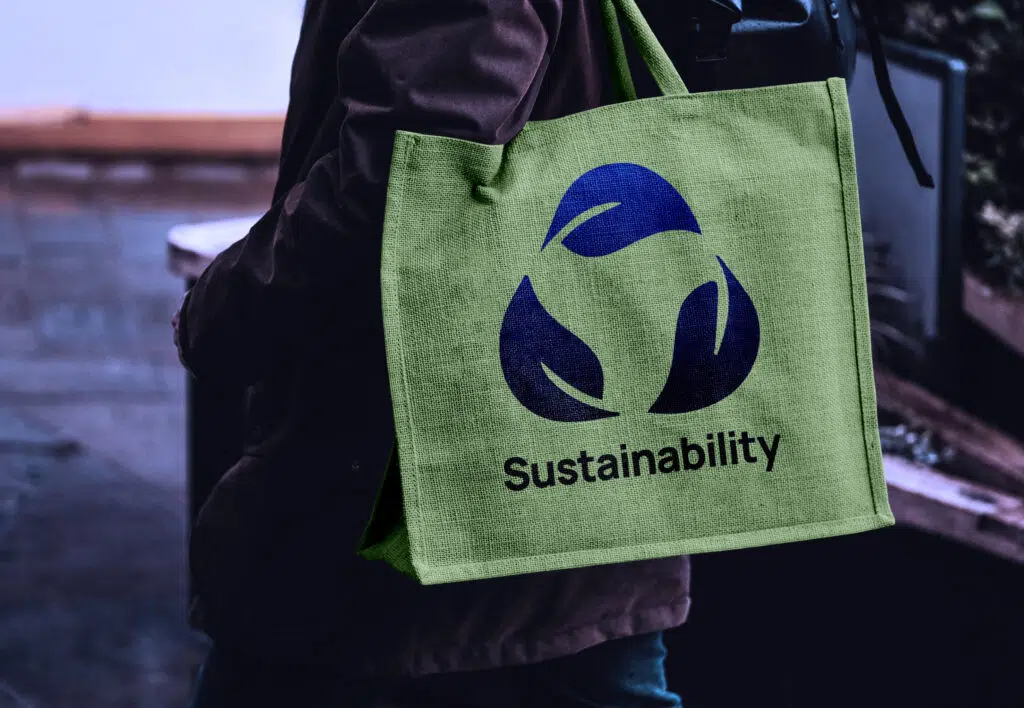Today, businesses must care about the planet and people.
Young shoppers, like Gen Z, check if brands use sustainable practices—like recyclable packaging or renewable energy—before buying. This shift isn’t just a trend; it’s about reducing environmental impact and showing social responsibility.
Sustainable branding means rethinking everything, from marketing strategies to ethical practices, to build consumer trust. Companies that focus on sustainability efforts earn brand loyalty because customers want their shopping habits to create a positive impact.
At Designers Choice, we use sustainable materials and fight climate change by designing for a better future.
Let’s explore how your brand can do the same.
What is Sustainable Branding?

Definition and Key Concepts
Sustainable branding is about making a brand that cares for the earth and social issues. It goes beyond green ads or making eco-friendly claims. True sustainable branding changes how a company runs its business from the start.
A sustainable brand focuses on three key areas: protecting the environment, helping people and communities, and earning money responsibly. This method looks at a product’s entire life cycle. It starts with using safe materials and ends with how customers use eco-friendly items.
Companies must consider their carbon footprint, energy use, and how their supply chains impact the world.
The Evolution of Branding Towards Sustainability
Branding has changed a lot over time. In the past, companies only wanted to make money.
Now, they must think about their duty to the Earth and society too. This change came because more people care about nature and the climate problem. The fashion world shows this change clearly.
Many clothing brands now use eco-friendly materials and pay fair wages to workers. They also try to end child work in their supply chains. Car companies like Tesla also show how green business ways can build a strong brand image.
Importance of Sustainable Branding

Environmental Impact
Our planet faces serious environmental issues. Companies must reduce their environmental footprint to help fight climate change. Sustainable branding helps businesses find new ways to use less energy and create less waste.
When companies focus on environmental sustainability, they often save money too. Using renewable energy and sustainable materials can lower costs over time. Water conservation and better energy consumption also help reduce business expenses.
Many companies now hire a chief sustainability officer to lead these environmental benefits.
Consumer Perception and Trust
Today’s shoppers, especially Gen Z, want brands that share their values about environmental responsibility.
They look for companies that use sustainable practices and care about social issues. This change in shopping habits means companies must be honest about their sustainability efforts.
Consumer trust grows when brands are open about their environmental impact. Companies that hide their real practices or make false environmental claims often lose customers quickly.
Social media makes it easy for people to share information about which brands care about sustainability and which ones don’t.
Competitive Advantage
Sustainable branding helps companies do better than regular products and services.
Brands that care about the earth often catch the attention of customers. These customers worry about nature and want to help. This makes these brands stand out in busy markets. Companies with good sustainability practices usually get more brand loyalty.
Customers like buying from brands that work for a better future. This feeling makes them buy again and share good words about the brand.
Core Principles of Sustainable Branding

Effective sustainable branding depends on following a few core rules.
Transparency and Authenticity
Honest communication forms the heart of sustainable branding. Companies must tell the truth about their sustainability initiatives and environmental impact. This means sharing both good news and challenges they face.
Transparency includes showing how products are made, where sustainable materials come from, and what workers earn. Companies should also be clear about their carbon offsetting efforts and renewable energy use.
Marketing materials should include real facts, not just nice-sounding words about being green.
Environmental Responsibility
Real environmental responsibility goes beyond just using recyclable packaging.
Companies must look at their whole environmental footprint, from product development to shipping. This includes choosing sustainable materials, reducing energy consumption, and finding ways to create less waste.
Many successful sustainable brands work toward carbon-neutral or net-zero goals.
They invest in renewable energy and find ways to reduce their carbon footprint across all business operations. The circular economy approach helps companies reuse materials and reduce waste even more.
Social and Economic Impact
Sustainable branding includes caring about people and communities. This means paying fair wages, ensuring safe working conditions, and supporting local communities. Companies should also think about how their products affect public health and safety.
Social responsibility extends to how companies treat their marketing team and other employees. Creating a positive work environment and supporting employee well-being shows that sustainability values go beyond just environmental focus.
Long-term Commitment and Innovation
Building a sustainable brand takes time and ongoing effort. Companies cannot just make a few green changes and call themselves sustainable. They need a long-term sustainability strategy that guides all business decisions.
Innovation plays a key role in sustainable branding. Companies must keep looking for new ways to reduce their environmental impact and create better products. This might mean developing new sustainable materials or finding more efficient ways to manufacture products.
Why Sustainable Branding Matters?

Consumer Demand and Market Trends
Market research shows that more people want green products and services. Studies say 81% of folks think companies should protect the earth. This number keeps rising, especially with younger buyers who will shape future trends.
Social media helps spread the word about nature issues and climate change. Customers now look up brands online before they buy anything. They also share their thoughts on how companies act. This makes it tough for companies to hide bad environmental or social behavior.
Business Benefits and Competitive Advantage
Sustainable branding creates many business benefits beyond just feeling good about helping the planet.
Companies often save money through more efficient energy consumption and waste reduction. They also attract customers who are willing to pay more for environmentally friendly products.
Strong sustainability practices help companies attract and keep good employees.
Many workers, especially younger ones, want to work for companies that match their values about environmental responsibility and social issues. This helps reduce hiring costs and improves worker satisfaction.
Regulatory and Investor Pressures
Governments all over the world are making new rules about taking care of the planet. They want more focus on social duty, too.
Companies need to get ready for tougher rules. These rules will cover carbon emissions, waste disposal, and how workers are treated. Good practices in sustainability today help companies meet future needs easily. Investors are also paying more attention to environmental and social issues. They consider these factors when choosing where to invest their money.
Companies that work hard on sustainability often find it easier to get funds. They may also see better stock values as a result.
Strategies For Implementing Sustainable Branding

Eco-Friendly Product Design
Creating green products starts with smart choices in design. Companies should consider the entire life of a product. This includes the green materials used and how customers will throw it away when finished. This method helps lessen harm to the environment at every step.
Good green design often means using less material while making items that last longer. This cuts down waste and saves cash for both firms and buyers. Many successful green brands also make products that can be easily recycled or reused in a circular system.
Ethical Sourcing and Supply Chains
Companies must choose wisely where they get their supplies and who makes their goods. Ethical sourcing is important. It ensures workers earn fair pay and work in safe places. This also means no child labor is used. It supports the communities where materials come from.
Supply chain clarity helps buyers know how products are made. Companies need to know their suppliers well. They should check often that these suppliers follow good rules for the earth and people. This information should be shared in ads and on social media platforms.
Transparent Communication
Honest talks about eco-friendliness help build trust with customers. It also creates loyalty to the brand.
Companies should share their wins and the things they need to work on. This means being open about their carbon waste, energy use, and other effects on the earth. Marketing plans should focus on teaching instead of just selling.
Blog posts, social media, and other ads can show customers about eco issues. They can also explain how customers can help. This way builds better ties than just trying to sell stuff.
Challenges in Sustainable Branding

- Greenwashing (False Claims): Some companies do not tell the truth about being green. They may claim to use eco-friendly ways. For example, a brand might use packaging that can be recycled. However, they may still hurt the Earth in other ways. This deceives customers and damages trust. It can also harm the brand’s good name.
- High Costs of Being Sustainable: Using green materials or paying fair wages costs more than the normal ways. Brands find it hard to keep prices low for buyers while being fair. For instance, eco-friendly goods can cost 75% more than regular goods. This makes them harder to sell.
- Measuring Environmental Impact: It is hard to see how much carbon a company uses. It is also tough to track energy use. Brands may not know how much waste their supply chains produce. They also may not know how to cut down on waste. Without clear facts, they cannot show that their green plans are working.
- Keeping Customers Interested: Even if brands want to be green, busy shoppers may still pick cheaper, non-eco options. For instance, Gen Z cares about climate change. However, high prices or unclear claims can turn them away. Brands need clear and honest messages. This helps them stay in people’s minds.
Measuring Impact and Success

Key Performance Indicators
Tracking the success of green efforts needs clear measures that show real progress.
Companies should check their carbon use, energy use, waste made, and water use. These numbers help find areas that need improvement and show change over time. Measures for social impact include tracking fair pay, worker safety, and support for local programs.
Companies should also check how happy customers are and how they see the brand’s green work. Regular surveys and checking social media help to know how customers think about the brand’s care for the Earth.
Reporting and Transparency
Regular reporting helps build trust with consumers. It shows a commitment to doing better over time.
Companies should share their green data in different ways. They can use annual reports, website updates, and social media posts. This information must be easy to understand. It should include both successes and problems faced.
Third-party checks can help prove claims about being green. These checks build trust in the brand’s actions. Groups like B Corp offer an independent look at company practices. These checks help shoppers find real green brands and steer clear of greenwashing.
Continuous Improvement
Sustainable branding needs constant work and updates to plans and goals.
Companies should check their sustainability plans often. They must look for new ways to cut down on harm to the environment. This can mean using new green materials, improving energy use, or finding better ways to help communities. New ideas are important for ongoing progress.
Firms should put money into research and development. This will help them find fresh solutions for environmental and social problems. This way, they can stay ahead of the competition while helping to make a better future.
Case Studies of Successful Sustainable Brands

Examples From Different Industries
Patagonia demonstrates excellent sustainable branding in the fashion industry through its commitment to environmental causes and ethical practices. The company encourages customers to repair rather than replace products through its “Worn Wear” program.
Patagonia also donates profits to environmental organizations and uses recycled materials in many products.
IKEA shows how large retailers can implement circular economy principles successfully.
The company plans to use only renewable or recycled materials by 2030 and offers services to help customers repair and resell used furniture. IKEA’s marketing efforts consistently highlight these sustainability practices while maintaining affordable prices.
Unilever’s Sustainable Living Plan demonstrates how consumer goods companies can integrate sustainability into all business operations.
The company works to reduce environmental impact while improving health and well-being for over a billion people. Their transparent reporting and regular updates build strong consumer trust.
Future Trends in Sustainable Branding

The future of sustainable branding will likely focus more on transparency and accountability as customers become more educated about environmental issues.
Digital technology will help companies track and share sustainability data more easily, making it harder to hide poor practices.
Circular economy principles will become more important as companies look for ways to reduce waste and reuse materials.
This approach will change how products are designed and how companies think about their business models. New sustainable materials and production methods will also create opportunities for innovation.
Consumer expectations will continue to grow, especially among Gen Z shoppers who prioritize environmental responsibility.
Companies will need to go beyond basic sustainable practices to stand out in the market. This means finding new ways to create positive impact and communicate their efforts effectively.
Conclusion
Sustainable branding is more than a simple marketing plan. It shows how businesses work and connect with their customers.
As we have seen in this guide, companies that care for the earth and help society build stronger loyalty and gain an edge. The secret to good sustainable branding is real commitment, not just small changes.
Companies should weave sustainability into all parts of their work, from making products to how they sell them. This means using eco-friendly materials and paying fair wages in their supply chains. They must also share clear information about their impact on the environment.
At Designers Choice, we think creating a green future needs teamwork among brands, customers, and communities.
By picking eco-friendly practices and backing brands with these values, we can all help make a positive impact. Moving forward takes ongoing effort, new ideas, and a promise to do better for our planet and future generations.
